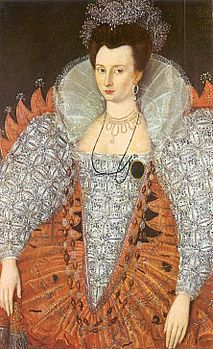- Mary Fitton
-
Mary Fitton 
Portrait of Mary Fitton circa 1595Born June 1578
Gawsworth, CheshireDied 1647 Spouse Captain Wiliam Polwhele Parents Sir Edward Fitton
Alice HalcroftMary Fitton (or Fytton) (Baptised 24 June 1578 – 1647) was the daughter of Sir Edward Fitton of Gawsworth, Cheshire and Alice Halcroft, and is considered by some to be the "Dark Lady" of Shakespeare's sonnets. Her elder sister, Anne, married John Newdigate in 1587, at the age of fourteen. She also had two brothers, about whom not much is known.
Contents
Life at court
About 1595 Mary Fitton became a maid of honour to Queen Elizabeth. Her father recommended her to the care of Sir William Knollys, comptroller of the Queen's household. Sir William promised, "I will be as careful of her well doing as if I were her own true father."[1] But Knollys, though fifty and already married, soon became suitor to Mary Fitton, in hope of the speedy death of the actual Lady Knollys. He wrote of his passion to her sister and even named Mary's niece, who he was sponsoring as godfather, "Mary". His infatuation was well known and mocked in court.
In 1599, Mary had to quit the court because of a mixture of physical and mental illnesses that Elizabethans called "the mother" or "suffocation of the mother" (a form of hysteria). When she returned to court, she refused Knollys.
In June 1600 Mary led a dance in the masque celebrating the fashionable wedding of Lady Anne Russell, granddaughter of the Earl of Bedford, with Henry Somerset, later created Marquess of Worcester, at Lord Cobham's residence in Blackfriars.[2] Led by Mary, the maids performed an allegorical dance and afterwards chose substitutes from the audience. Mary boldly chose the queen, telling her that she represented Affection (which then meant passionate love), to which the queen replied "Affection? Affection's false."
William Herbert, later Earl of Pembroke, is known to have been present at this affair. Mary was a couple of years older than he, but she pursued him ardently. She became his mistress, and was soon pregnant. In February 1601 Pembroke was sent to the Fleet Prison after admitting paternity but refusing to marry his mistress. Mary Fitton was placed with Lady Margaret Hawkins, the widow of Sir John Hopkins, for her confinement. In March 1601 she gave birth to a baby boy who died immediately (perhaps from syphilis, which it is believed Pembroke may have suffered from).
Both Mary and Pembroke were dismissed from court.
Shakespeare
The relationship with Herbert is the basis for the claim that Fitton was the "dark lady" of Shakespeare's sonnets. Herbert is one of the main candidates for the identity of the Fair Youth, a character who betrays the poet by having an affair with the Dark Lady, hence the claim that Fitton might be the lady. The suggestion was first made by Thomas Tyler in his 1890 edition of the sonnets. It was taken up by Frank Harris in several books, including The Women in Shakespeare and Shakespeare and his Love. His influential biography The Man Shakespeare asserted that Fitton had ruined Shakespeare's life and that he died "broken hearted for love of the Dark Lady."[3]
Later scholars have not pursued these assertions. Paul Edmondson and Stanley Wells comment that "her star waned when she was discovered to have been fair".[4] There is no hint in her authenticated biography that she was acquainted with Shakespeare. William Kempe, who was a clown in Shakespeare's company, dedicated his Nine Daies Wonder to Mistress Anne (perhaps an error for Mary) Fitton, Maid of Honor to Elizabeth; and there is a sonnet addressed to her in an anonymous volume, A Womans Woorth defended against all the Men in the World.
Life after Court
Mary did not seem as abashed by the business as her father, who considered it to be social ruin. Knollys tried to woo her once again, but Mary was firm. She had an affair with the married Vice-Admiral Sir Richard Leveson, who left her £100 after his death in 1605 (his wife had to be committed to the care of her father).
After this she had an affair with Captain Wiliam Polwhele and bore a son that was presumably his. Her mother was scandalized, writing to her other, married, daughter, "such shame as never had a Cheshire woman, worse now than ever. Write no more to me of her."[5] Even after marriage to the father of her child, her mother referred to him as "a very knave". When Polwhele died in 1610, Mary had a son and daughter to take care of.
She married again, to a Pembrokeshire captain named Lougher. He died in 1636. She died in 1647 and was buried in Gawsworth, leaving a little Welsh property to her daughter who had married and had children herself.
Footnotes
- ^ Haynes, Alan: Sex in Elizabethan England 1997:44.
- ^ Noted in J.G. Waller, "The lords of Cobham, their monuments and the church" Archaeologia Cantiana (The Kent Archaeological Society) 1878:157.
- ^ Sunil Kumar Sarker, Shakespeare's sonnets, Atlantic, 2006, p.101-2.
- ^ Paul Edmondson, Stanley Wells, Shakespeare's Sonnets, Oxford University Press, Oxford, 2004, p.25.
- ^ Haynes, Alan. Sex in Elizabethan England 1997:49.
References
- Haynes, Alan. Sex in Elizabethan England. Gloucestershire: Sutton Publishing Limited, 1997. ISBN 0-905-778-359
 This article incorporates text from a publication now in the public domain: Chisholm, Hugh, ed (1911). Encyclopædia Britannica (11th ed.). Cambridge University Press.
This article incorporates text from a publication now in the public domain: Chisholm, Hugh, ed (1911). Encyclopædia Britannica (11th ed.). Cambridge University Press.
Categories:- Sonnets by William Shakespeare
- Maids of Honour
- 1578 births
- 1647 deaths
- People from Cheshire
- 16th-century English people
- 17th-century English people
- 16th-century women
- 17th-century women
- Women of the Tudor period
- Fitton family
Wikimedia Foundation. 2010.
